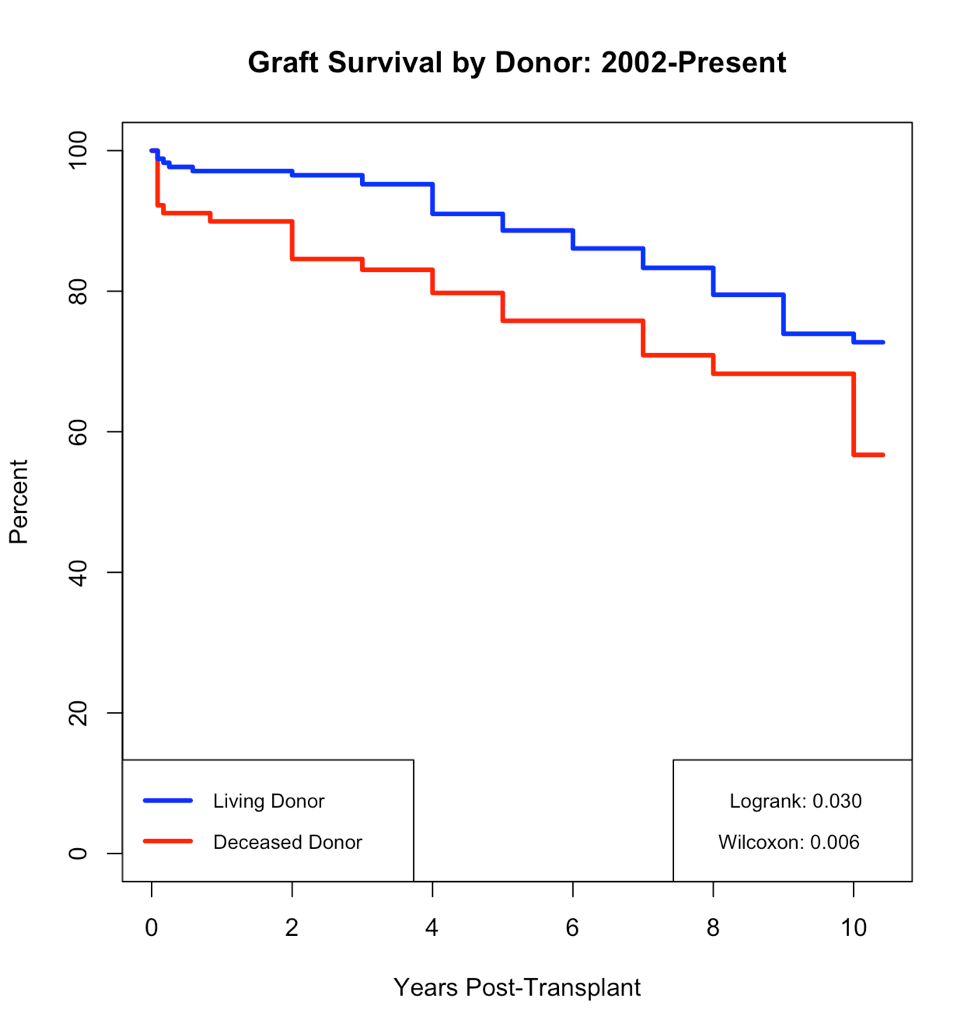Outcomes and Risk Factors for Graft Loss: Lessons Learned from More Than 1,056 Pediatric Kidney tx at a Single Center.
U of M, M
Meeting: 2017 American Transplant Congress
Abstract number: D174
Keywords: Graft failure, Immunosuppression, Outcome, Risk factors
Session Information
Session Name: Poster Session D: Kidney: Pediatric
Session Type: Poster Session
Date: Tuesday, May 2, 2017
Session Time: 6:00pm-7:00pm
 Presentation Time: 6:00pm-7:00pm
Presentation Time: 6:00pm-7:00pm
Location: Hall D1
Aim:To study outcomes and risk factors for graft loss in > 1056 pediatric renal tx.
Methods:We studied outcomes by immunosuppression era: I) 1963-83 (ALG, AZA and steroids); II) 1984-2001 (calcineurins); and III) 2001-(steroid avoidance protocol).
Results: 1056 transplants (Age<1yr=53, 1-2yr=124, 3-5yr=182, 6-10yr=216, 11-18=435) were performed (810 primary transplants; 246 re-transplants) (Living Donor [LD]=69%, Deceased Donor[DD]=31%; 3% Living unrelated donors[LURDs] pre-2001, increased to 17% since 2001 [p<.01]). Ten year patient survival (p <0.001), graft survival (p=0.0005), and death-censored graft survival (p=.02) steadily improved by era. Graft half-life (starting @ 1 yr post tx) is 25 years for LDs compared to 13 years for DDs. Graft loss for all causes < 1 year post tx has < by era; From 1-5 yrs, Chronic rejection/ IFTA remains predominant. For the entire cohort and all eras including post share 35 era LD was associated with superior graft survival. Risk factors for graft loss per cox hazard regression are listed below
| Variable | Hazard Ratio | UCL | LCL | P | LABEL |
| Living donor | 0.573 | 0.462 | 0.712 | <0.0001 | |
| primary vs re tx | 1.327 | 1.038 | 1.696 | 0.0238 | |
| Era 1 vs 3 | 1.678 | 1.213 | 2.321 | 0.0018 | |
| Era 2 vs 3 | 2.369 | 1.719 | 3.266 | <0.0001 | |
| recipient age 11-18yrs | 1.409 | 1.144 | 1.736 | 0.0013 | |
| PRA level >50 | 2.404 | 1.6 | 3.613 | <0.001 | |
| No of HLA mis matches | 1.153 | 0.271 | 8.42 | 0.6372 | |
| Pre tx Urological issues | 1.972 | 1.024 | 3.798 | 0.0424 | |
| Pre emptive tx | 2.993 | 1.188 | 7.540 | 0.020 | |
Successful transplant was associated with improved quality of life, and return to school.
Long term outcomes of pediatric renal tx have continued to improve. LD grafts continue to provide the most long-term benefit and should be the first option even in the current allocation system.Children <10yr now have the best long term survival.
CITATION INFORMATION: Chinnakotla S, Verghese P, Chavers B, Kirchner V, Najarian J. Outcomes and Risk Factors for Graft Loss: Lessons Learned from More Than 1,056 Pediatric Kidney tx at a Single Center. Am J Transplant. 2017;17 (suppl 3).
To cite this abstract in AMA style:
Chinnakotla S, Verghese P, Chavers B, Kirchner V, Najarian J. Outcomes and Risk Factors for Graft Loss: Lessons Learned from More Than 1,056 Pediatric Kidney tx at a Single Center. [abstract]. Am J Transplant. 2017; 17 (suppl 3). https://atcmeetingabstracts.com/abstract/outcomes-and-risk-factors-for-graft-loss-lessons-learned-from-more-than-1056-pediatric-kidney-tx-at-a-single-center/. Accessed December 14, 2025.« Back to 2017 American Transplant Congress
